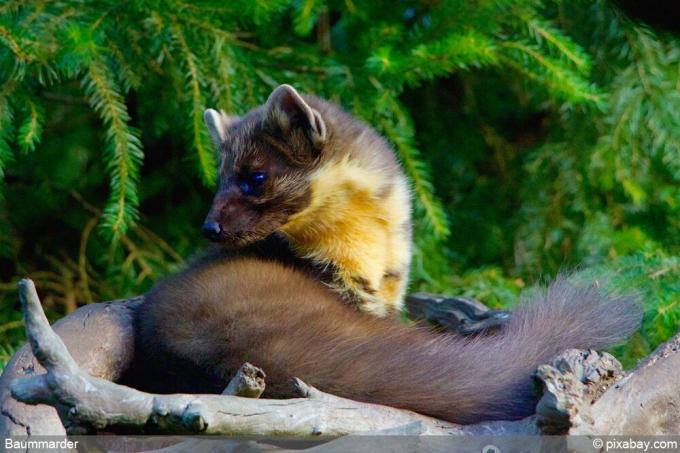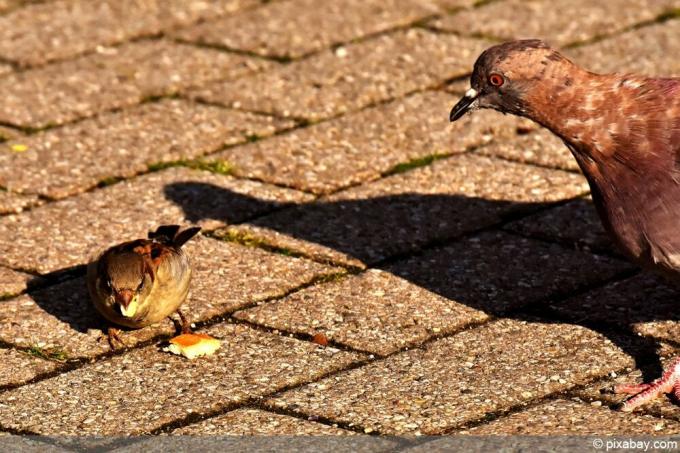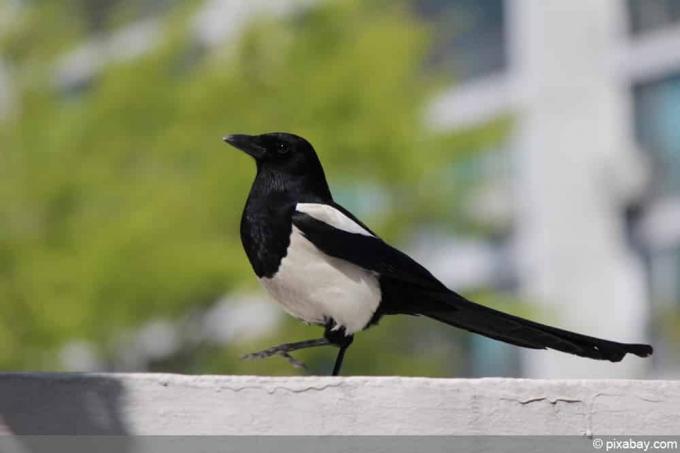

Table of contents
- PROFILE - Pine marten
- diet and lifestyle
- Natural enemies
- reproduction and maternity leave
- Distinguish pine marten and stone marten
The treetops of large forest areas are its territory. The pine marten is considered the most ingenious acrobat among European mammals. We can only rarely admire its climbing skills, because the shy forest dweller – in contrast to the stone marten – avoids close proximity to humans. This fact sheet will familiarize you with fascinating details about the precious marten. Read here how the little robber lives, what food he prefers and what natural enemies he has to fight against.
PROFILE - Pine marten
- Genus Real Marten (martes) within the canid carnivore family
- Name of the species: pine marten (Martes martes)
- Further designation: noble marten
- Circulation area: contiguous forests in Europe and western Asia up to the tree line
- Head torso length: 45 to 58 cm (excluding the bushy tail)
- tail length: 16 to 28 cm
- Weight: 800 to 1800 grams
- fur color: chestnut to dark brown
- Typical feature: yellow, unforked throat spot (yellowthroat)
- ears: short, triangular with thin yellow margins
- Short legs with very hairy paws
- Strong bite with 38 teeth
- Activity: mainly crepuscular and nocturnal
- Life expectancy: up to 10 years in the wild, up to 16 years in captivity
The pine marten uses its long, bushy tail as an organ of balance when swinging from branch to branch at a height of up to 10 meters. The furry acrobat jumps up to 4 meters wide. The low body fat percentage, paired with a slim shape, optimize the climbing and jumping abilities of the agile predator. The forest dweller compensates for the lack of a thick layer of fat to insulate against the cold with an extra thick winter coat, to which it owes the name marten. The silky winter fur made the pine marten a coveted prey for a long time. Therefore, the beautiful fur carrier has become rare in many regions. In 2014 the marten was removed from the list of huntable species.
diet and lifestyle

Pine martens are omnivores with a strong preference for small mammals, birds and eggs. The loners spend most of the day in one of their nests, which are located in tree cavities. Sometimes the clever forest dwellers also convert an abandoned squirrel den or an empty bird of prey nest into a den. At dusk, the robber goes in search of food on and under the trees in the forest, always at a safe distance from people. This prey is on his menu:
- birds and their eggs
- mice of all kinds
- frogs and small reptiles
- Squirrel
- insects and snails
- fruits and nuts
The marten kills prey with a targeted bite on the neck. On site, it rarely eats its prey. Rather, the predator likes to transport its food to the nearest tree in order to eat some of it there in peace and to deposit the leftovers. For the cold season, the pine marten sets up various stores because it does not take a winter break. He doesn't have to be afraid of the harsh winter. Frosty temperatures reduce the escape distance of its preferred prey, so that in winter it can even reduce its territory by up to 50 percent without going hungry.
Natural enemies
A natural enemy from the animal kingdom for the pine marten is primarily the fox. The wild dog is widespread in Europe and shares its habitat with the pine marten. Both predators are active at dusk and at night, so encounters are inevitable that don't end well for the smaller and lighter marten.
The pine marten is a highly coveted prey for eagles and eagle owls. Nocturnal hunters, such as the lynx, also target careless goldthroats. However, these enemies have now become just as rare as the pine marten itself. Therefore, man takes the undisputed top position in the inglorious ranking of deadly adversaries. In earlier times, hunters were after the silky fur of the forest dweller. Today, the marten lacks a habitat, since contiguous forest areas are being destroyed by humans.
reproduction and maternity leave
Pine martens live as territorial solitary animals. Males mark their territory with scent marks and defend it vehemently against same-sex competitors. However, a male's territory often overlaps with that of several females. During the mating season (mating season) in midsummer, things get busy in the treetops when the competing males hiss and rampage screeching to present themselves to a mating female as the perfect sire for the Offspring.
The gestation period of a female extends over about 8 months, because an egg rest ensures that the 8 to 10 cm little boys see the light of day in spring. The 3 to 6 cubs are born blind and can see after 4 to 5 weeks. They leave the nest at 8 weeks and are largely independent by 16 weeks. It is not uncommon for the offspring to stay with the mother until the following spring, as female pine martens mate at 2-year intervals.
Tip:
Pine martens are the cross-country skiers among the real martens. On their short legs they cover 5 to 8 kilometers on the ground in one night when the predators are on the prowl. When food is scarce, goldthroats travel an impressive 15 kilometers in search of a meal.
Distinguish pine marten and stone marten

Due to their close relationship, pine martens and stone martens look confusingly similar. With regard to their way of life, both marten species differ significantly. Above all, the stone marten seeks closeness to humans, which provokes numerous conflicts. The beech marten is responsible for many a costly engine failure because it likes to nibble on cables. He also likes to hang around in attics and acts as a nocturnal poltergeist, robbing the human residents of their sleep. You can distinguish between pine martens and stone martens based on the following characteristics:
throat patch
- Pine marten: yellow and unforked
- Beech marten: white and divided into a double bifurcation
height and weight
- Pine marten: 80 to 85 cm long, 800 to 1,800 grams in weight
- Beech marten: 40 to 75 cm long, 1,100 to 2,300 grams in weight
Nose
- Pine marten: dark
- Beech marten: light to pink
paws
- pine marten: very hairy
- Beech marten: no hair
Apparently, both marten species avoid each other, because no crossings have occurred so far. Thus, pine martens and beech martens are considered a shining example of evolution, of how related predators share habitat to avoid destructive competition for food.
 garden editorial
garden editorial I write about everything that interests me in my garden.
Learn more about animal defense

Bird repellent: with these means you drive birds away from the balcony
Pigeons, sparrows and many other bird species often choose a balcony as a resting or even nesting place in the city. However, to ensure that your own balcony is spared bird droppings in particular, there are various measures that can be used effectively here without harming the animals.

Scare away foxes from the garden and keep them away
Whether in the city or in the country - more and more hobby gardeners meet foxes in their own green kingdom and ask themselves how they can scare them away. We have summarized which measures are best suited for this in this article!

Prevent birds under roof tiles and roof overhang
If birds settle under the roof tiles and the roof overhang, this can lead to damage to the building fabric. The droppings cause unsightly dirt, and breeding songbirds make a lot of noise. Various countermeasures have proven effective in preventing unwanted colonization.

Remove sparrow nest under the roof
Where people live, sparrows are not far either. With a few exceptions, this applies all over the world. Sparrows are cultural followers, they have adapted to the way of life of humans. What to do if sparrows breed under the house roof?

Recognizing magpie droppings | Magpie droppings with picture
Bird droppings on the terrace or on the light wall of the house are a nuisance. What culprit is behind this? Was it the magpies? We'll show you how to spot magpie droppings and how to get rid of them.

Recognize badger droppings in the garden: 6 characteristics
Have you ever seen a badger in the wild? The animals with the black stripes on their faces are common in German forests. She is increasingly drawn to the city. Their legacies are annoying. How can badger droppings be identified?
